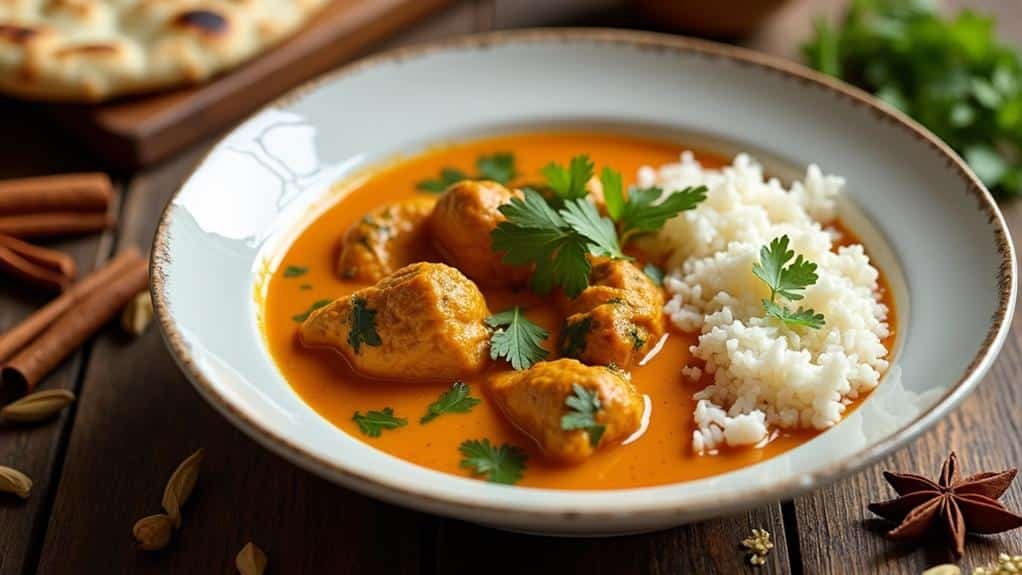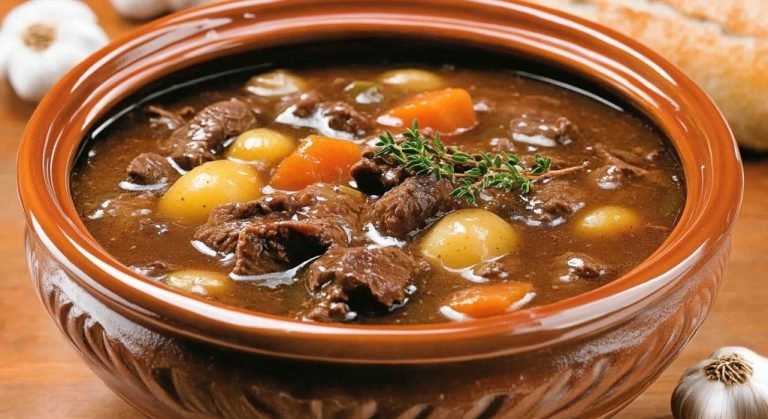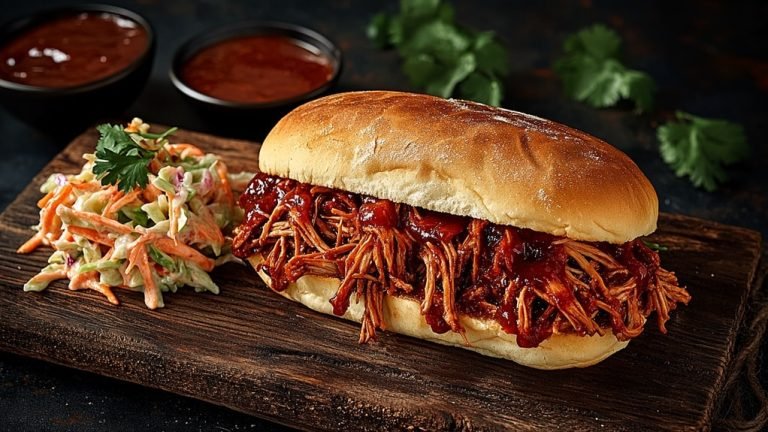You’ve probably heard of chicken curry, but have you ever tried making it at home? This popular dish, with its rich blend of spices and creamy sauce, might seem intimidating at first. However, you’ll be surprised to learn that creating a delicious chicken curry can be quite simple. Whether you’re a novice cook or an experienced chef, this easy recipe will help you bring the flavors of India to your dinner table. As you explore the history, ingredients, and cooking steps, you’ll discover why this dish has become a favorite in households around the world. But before we dive into the details…
Key Takeaways
- Chicken curry combines tender chicken with aromatic spices in a creamy tomato-based sauce.
- The dish can be prepared in under an hour, making it suitable for weeknight dinners.
- Key ingredients include chicken thighs, curry powder, coconut milk, and diced tomatoes.
- Sautéing onions, adding spices, simmering with coconut milk, and incorporating vegetables are essential steps.
- Serve over steamed rice or with warm naan bread for a complete, flavorful meal.
History
Chicken curry’s origins can be traced back to the Indian subcontinent, where it’s been a staple dish for centuries. You’ll find that the word “curry” itself comes from the Tamil word “kari,” which means sauce or relish for rice. As you explore the history of this dish, you’ll discover that it’s not just one recipe, but a whole category of spiced, saucy dishes that vary greatly across regions and cultures.
When you’re making chicken curry, you’re participating in a culinary tradition that’s been passed down through generations. The British, who ruled India for nearly 200 years, fell in love with curry and brought it back to England. From there, it spread across the globe, adapting to local tastes and ingredients along the way.
You’ll notice that curry has evolved differently in various countries, from the coconut-based curries of Thailand to the roux-thickened curries of Japan. As you cook, you’re not just preparing a meal, but participating in a rich, global culinary history that spans centuries and continents.
Recipe
This easy chicken curry recipe is perfect for those who want to explore Indian flavors without spending hours in the kitchen. Combining aromatic spices with tender chicken pieces and a creamy tomato-based sauce, this dish offers a comforting and satisfying meal that can be prepared in under an hour.
The beauty of this recipe lies in its simplicity and adaptability. You can adjust the spice levels to suit your taste preferences, and even experiment with different vegetables to make it your own. Serve this curry over steamed rice or with warm naan bread for a complete and delicious meal that will transport your taste buds to the streets of India.
- 1 lb boneless, skinless chicken thighs, cut into bite-sized pieces
- 2 tablespoons vegetable oil
- 1 large onion, finely chopped
- 3 cloves garlic, minced
- 1 tablespoon grated fresh ginger
- 2 tablespoons curry powder
- 1 teaspoon ground cumin
- 1 teaspoon ground coriander
- 1/4 teaspoon cayenne pepper (optional)
- 1 can (14.5 oz) diced tomatoes
- 1 can (13.5 oz) coconut milk
- Salt and pepper to taste
- Fresh cilantro for garnish
Heat oil in a large skillet over medium heat. Add onion and cook until softened, about 5 minutes. Add garlic and ginger, cook for another minute. Stir in curry powder, cumin, coriander, and cayenne pepper, cooking until fragrant. Add chicken pieces and cook until browned.
Pour in diced tomatoes and coconut milk, bring to a simmer. Reduce heat and cook for 15-20 minutes until chicken is cooked through and sauce has thickened. Season with salt and pepper to taste. Serve hot, garnished with fresh cilantro.
For best results, marinate the chicken in yogurt and a pinch of the spices for a few hours before cooking to enhance flavor and tenderness. If you prefer a thicker sauce, you can add a cornstarch slurry (1 tablespoon cornstarch mixed with 2 tablespoons water) towards the end of cooking. Feel free to add vegetables like bell peppers, potatoes, or spinach to make it a more complete meal.
Leftovers can be stored in the refrigerator for up to 3 days and often taste even better the next day as the flavors continue to meld.
Cooking Steps
You’re about to embark on a culinary journey to create a mouthwatering chicken curry, and the cooking steps are straightforward yet crucial for achieving the perfect balance of flavors. As you stand at your stove, ready to transform simple ingredients into a fragrant and comforting meal, you’ll begin by sautéing onions until they’re soft and translucent.
Then add the chicken and aromatic spices that will form the foundation of your curry. Once the chicken is sealed and coated in spices, you’ll pour in creamy coconut milk, allowing the mixture to simmer gently, before finally adding colorful vegetables and garnishes that will elevate your dish from good to extraordinary.
Step 1. Sauté Onions Until Translucent
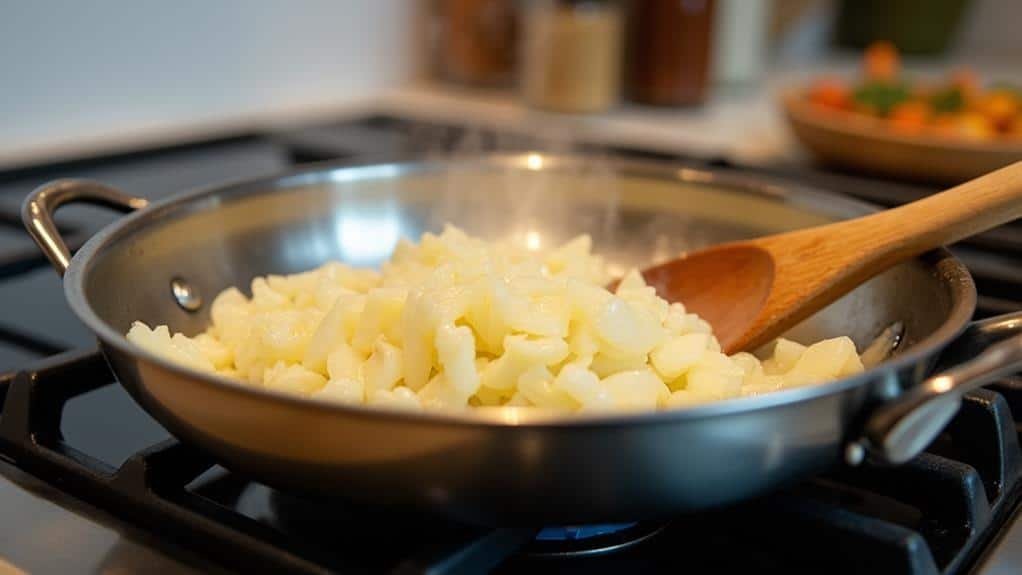
To begin the cooking process, heat some oil in a large pan or skillet over medium heat. Once the oil is shimmering, it’s time to add your diced onions. You’ll want to use about one medium-sized onion for this recipe, which you’ve already chopped into small, uniform pieces. Gently slide the onions into the hot oil, and you’ll hear a satisfying sizzle as they hit the pan.
Now, here’s where patience comes into play. Sautéing onions until they’re translucent is a crucial step that builds a flavorful base for your curry.
As you stir the onions with a wooden spoon, you’ll notice them softening and becoming glossy. This process usually takes about 5-7 minutes, during which the onions will release their natural sugars and develop a sweet, aromatic flavor. Keep a close eye on them, stirring occasionally to ensure even cooking.
The onions are ready when they’ve turned a pale, golden color and you can almost see through them. This step, while simple, is essential for creating depth in your curry, as it allows the onions to meld seamlessly with the other ingredients.
Step 2. Add Chicken and Spices
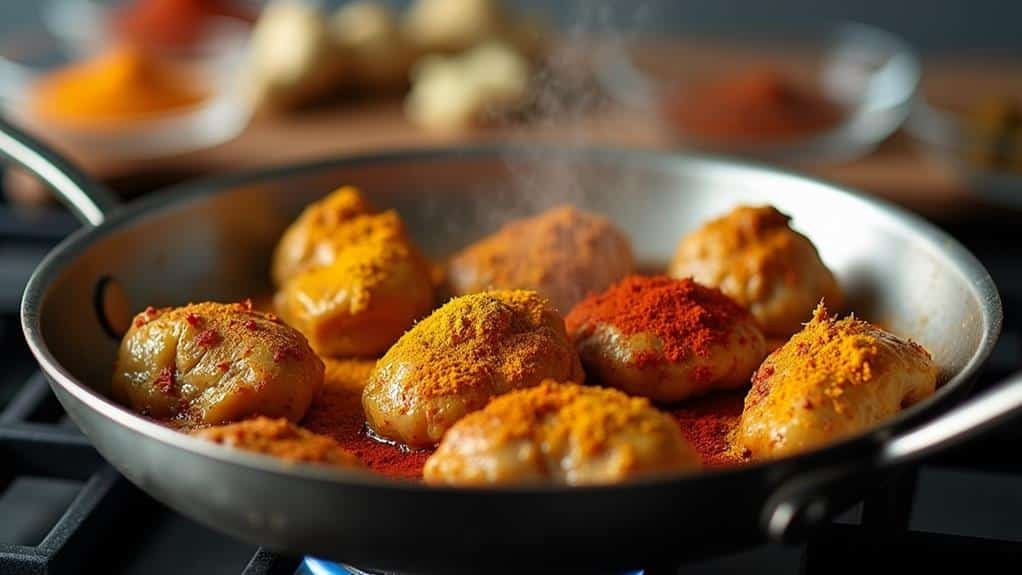
Once the onions are translucent, it’s time to add the star of the dish: the chicken. Cut your boneless, skinless chicken breasts into bite-sized cubes, ensuring they’re all roughly the same size for even cooking. Add the chicken to the pan with the onions, stirring to coat it in the fragrant oil. As the chicken begins to cook, you’ll notice its color changing from pink to white.
Now, it’s time to introduce the spices that’ll transform this simple dish into a flavorful curry. Sprinkle in generous amounts of curry powder, turmeric, and garam masala, which will infuse the chicken with warm, earthy flavors. Don’t forget to add a pinch of salt and black pepper to enhance the overall taste.
As you stir the spices into the chicken, you’ll be enveloped by an aromatic cloud that hints at the delicious meal to come. The spices will form a golden coating on the chicken pieces, creating a visually appealing dish. Continue cooking for about 5-7 minutes, or until the chicken is no longer pink in the center and has absorbed the spices’ flavors.
Step 3. Add Coconut Milk and Simmer
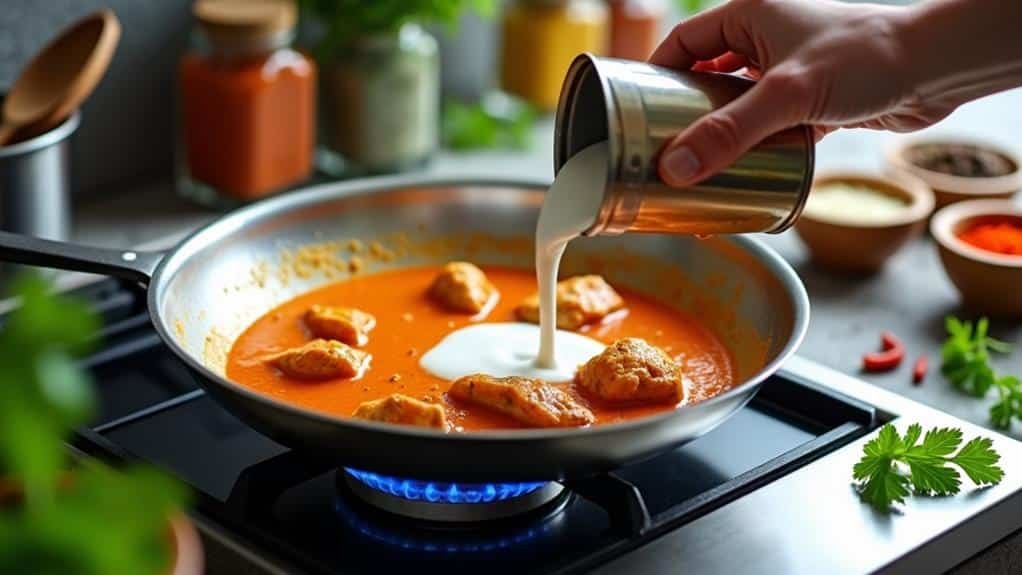
The rich aroma of spices fills the kitchen as you prepare to add the final key ingredient. It’s time to introduce the creamy, luxurious coconut milk that will transform your curry into a velvety delight. Carefully pour the coconut milk into your simmering pot, watching as it swirls and blends with the vibrant spices and tender chicken pieces.
As you stir the mixture, you’ll notice the sauce starting to take on a beautiful golden hue, a hallmark of traditional Indian curries. Reduce the heat to low and let the curry simmer gently for about 15-20 minutes, allowing the flavors to meld and intensify.
During this time, the chicken will continue to cook and absorb the aromatic spices, while the sauce thickens to the perfect consistency.
Keep an eye on your curry, stirring occasionally to prevent it from sticking to the bottom of the pot. You’ll know it’s ready when the chicken is cooked through and the sauce has reduced slightly, coating the back of a spoon.
This simmering process is crucial, as it allows the coconut milk to infuse the dish with its subtle sweetness and rich texture.
Step 4. Add Vegetables and Garnishes
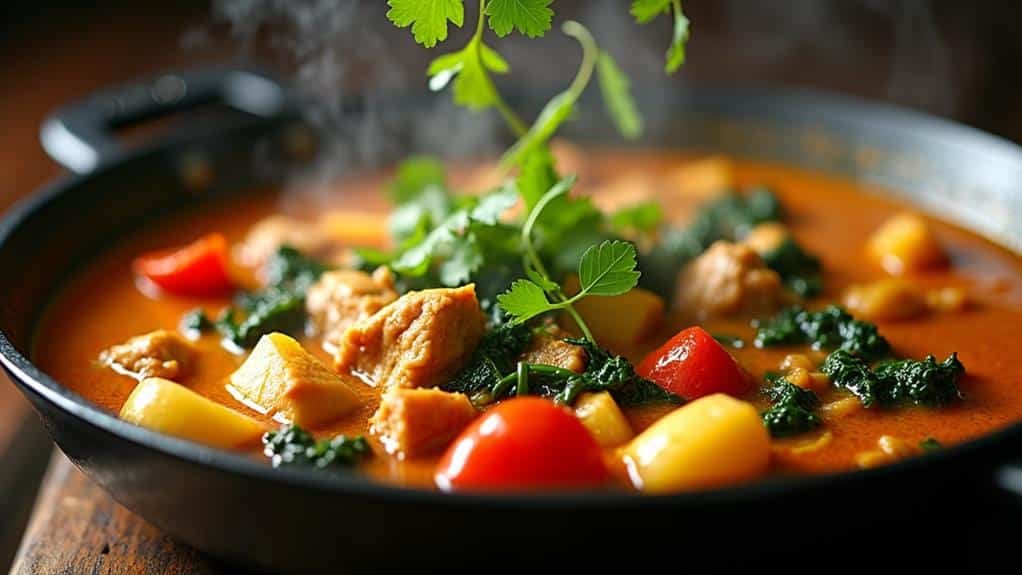
Brimming with aromatic flavors, your curry is nearly complete. Now it’s time to add some colorful vegetables to enhance both the nutritional value and visual appeal of your dish.
Carefully slice bell peppers, carrots, and green beans into bite-sized pieces, ensuring they’re uniform in size for even cooking. Gently stir these vibrant veggies into your simmering curry, allowing them to soften and absorb the rich flavors of the sauce.
As the vegetables cook, prepare your garnishes. Finely chop fresh cilantro, its bright green leaves adding a pop of color and a refreshing taste to your curry. If you’re feeling adventurous, thinly slice some red chilies for an extra kick of heat.
Once your vegetables are tender but still slightly crisp, it’s time to plate your masterpiece. Ladle the curry into bowls, making sure each serving has a generous helping of chicken and vegetables. Sprinkle the cilantro over the top, and if you’re using them, add a few chili slices.
The final touch? A wedge of lime on the side, ready to be squeezed over the curry, adding a zesty brightness that’ll make your taste buds sing.
Step 5. Serve Over Steamed Rice
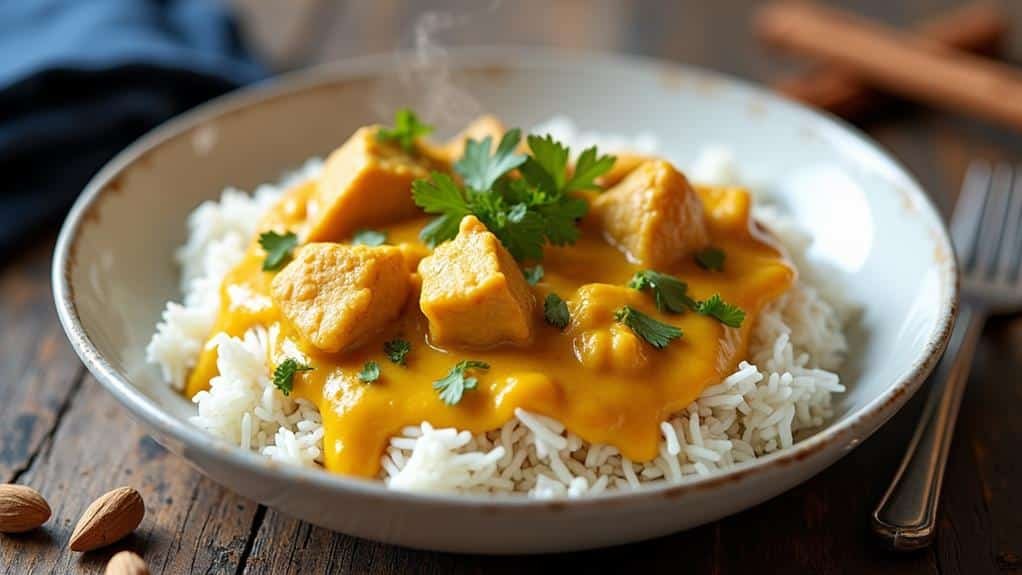
While your curry simmers, it’s time to prepare the perfect bed of fluffy rice to complement your dish. Start by rinsing your rice thoroughly under cold water until the water runs clear, which removes excess starch and ensures each grain remains separate. If you’re unsure how to about this process, you can refer to our detailed guide How to Cook Perfect Rice.
For every cup of rice, you’ll need about 1.5 cups of water. In a medium saucepan, bring the water to a boil, then add your rinsed rice and a pinch of salt. Reduce the heat to low, cover the pan with a tight-fitting lid, and let it simmer for about 18-20 minutes.
Once the time’s up, remove the pan from heat but don’t lift the lid! Let it sit, covered, for another 5-10 minutes. This resting period allows the rice to absorb any remaining moisture and become perfectly tender.
When you’re ready to serve, gently fluff the rice with a fork to separate the grains. Scoop a generous portion onto each plate, creating a soft, steaming foundation for your aromatic chicken curry. The fluffy rice will soak up the rich, flavorful sauce, making every bite a delightful combination of textures and tastes.
Final Thoughts
With its blend of aromatic spices and creamy sauce, this easy chicken curry recipe is sure to become a family favorite.
You’ll find that this dish isn’t only delicious but also versatile, allowing you to adjust the spice level to suit your taste buds.
As you’ve learned, curry has a rich history dating back centuries, originating in the Indian subcontinent before spreading across the globe.
Frequently Asked Questions
Can I Make Chicken Curry in a Slow Cooker?
You chop, you season, you pour—and yes, you can make chicken curry in a slow cooker! It’s a convenient method that’ll infuse your meat with rich flavors. Just adjust liquid amounts and cooking time for optimal results.
What Are Good Side Dishes to Serve With Chicken Curry?
You’ll love pairing your chicken curry with fluffy basmati rice or naan bread. Try adding a fresh cucumber raita, mango chutney, or spicy pickles. For veggies, serve sautéed spinach or roasted cauliflower on the side.
How Long Does Homemade Chicken Curry Last in the Refrigerator?
Have you ever wondered about the shelf life of your culinary creations? You’ll be glad to know that homemade chicken curry typically lasts 3-4 days in the refrigerator. Make sure you store it in an airtight container for optimal freshness.
Is It Possible to Freeze Chicken Curry for Later Use?
Yes, you can freeze chicken curry for later use. It’s a great way to save time and have meals ready. You’ll want to cool it completely before freezing. It’ll last up to 3 months in the freezer.
Can I Substitute Coconut Milk With a Non-Dairy Alternative?
You can substitute coconut milk with non-dairy alternatives. Try unsweetened almond milk, cashew milk, or oat milk. They’ll change the flavor slightly, but they’ll work well in your curry. Just make sure to choose unsweetened varieties for best results.

